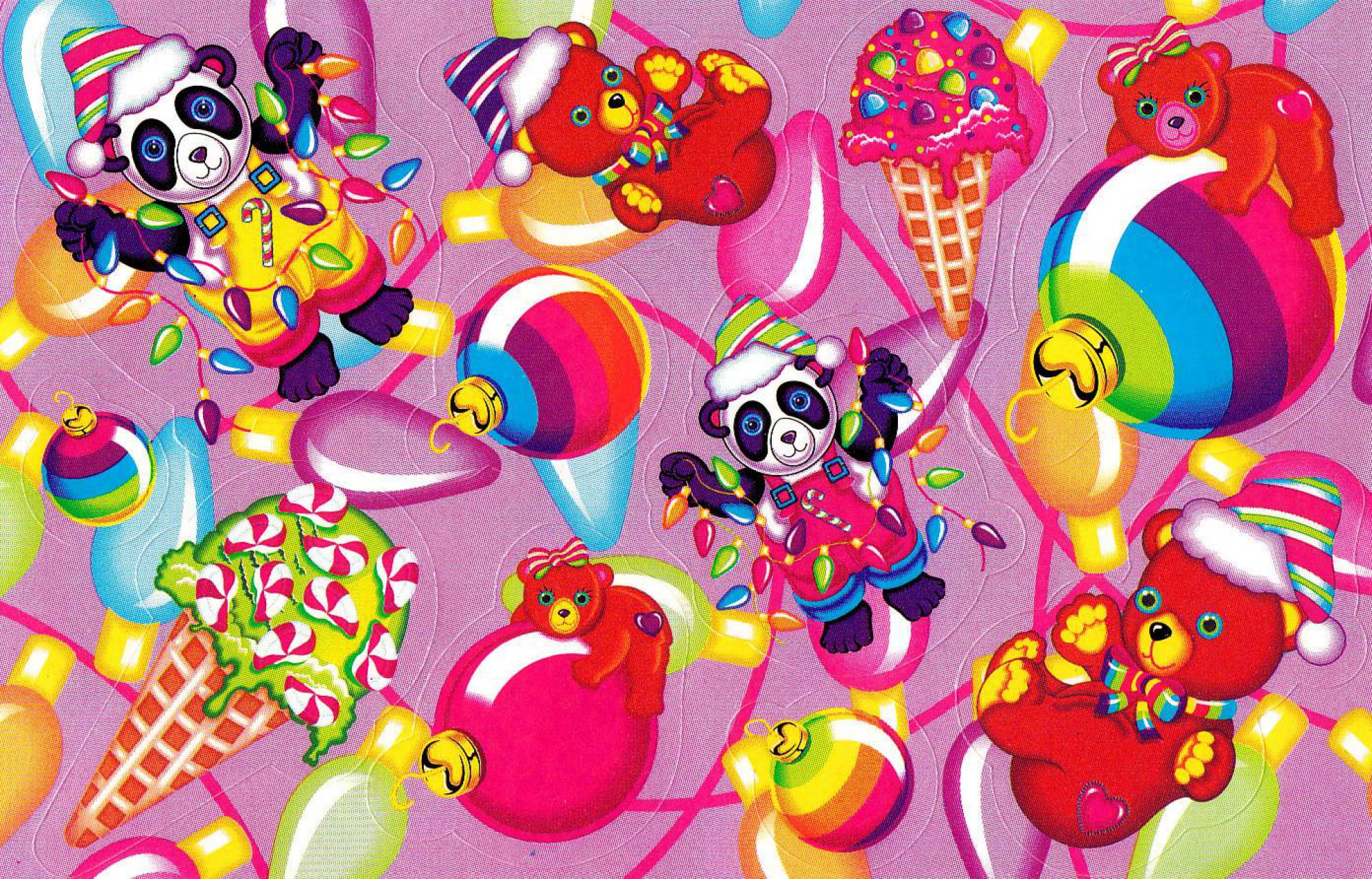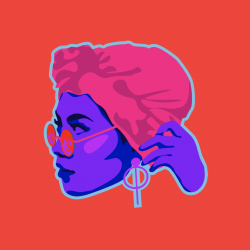
Yay museum trip! It had been a while since I went to a museum ever since school started, and I was excited to see what the Art Science Museum had in store. The Exhibition that we went to was Human+, where from the cover art of the exhibition guide, I could infer was about technology. (Usually, I don’t read exhibition guides because I like to play a game of “guess what the artwork means”.) However, after speed reading through the blurb of the exhibition, I gathered that this exhibition was going to be about how we treat technology, whether we are obsessed with them, use them in everyday lives, or doing inhuman or unethical modifications to nature through them.
Below are two of the works that I was most intrigued with:
TARDIGOTCHI
S.W.A.M.P (MATT KENYON & DOUGLASS EASTERLY WITH TIAGO RORKE), 2010
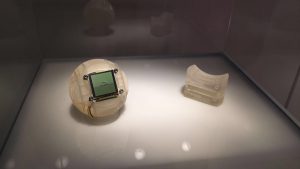
Spherical in shape, Tardigotchi was created by Matt Kenyon & Douglass Easterly with Tiago Rorke. This was created to examine the grey area between life and artificial life, as it features two pets: a living organism and an artificial life avatar.
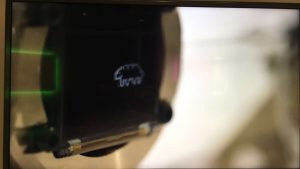
The sphere is divided into two: one half is a brass sphere with an avatar depicted on the screen, and the other is a prepared slide, where tardigrade lives. On first impression, it reminded me of a Tamagotchi from the 90s. It was put on display behind a clear casing, and the object was small enough to fit into a hand.
Preliminary Read
At first, this work did not look like anything too much to me because of its’ small size and basic colors. To me, it looked like a boring Tamagotchi. However, I was intrigued by this because the video it was playing was at a frame of the ‘loner’, looking down at something in his hand and just staring at it. I thought this was peculiar because it did not look as ‘animated’ as the other works, but the person was just staring at it. From there, I decided to take a look at what could be so interesting about this little ball.
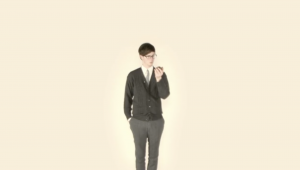
I felt that the artist was motivated to do this work as humanity has moved into the technological golden age, where most of us rely on technology as it can do everything we want, even to the extent of caring for digital life. What I thought the artist had wanted to reflect was of a society that wanted to move into the ‘future’ so much that we had started to replace real life pets, with an avatar on the screen, and the obsession of wanting to make everything digital and automated.
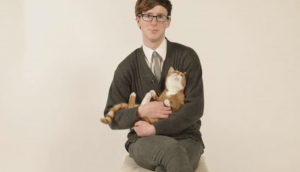
I came to this conclusion because when I saw the piece, I only saw the front part of the sphere, with the LED screen, and watched the video next to it. The audio of the video could not be heard, and the words on the screen did not help to explain the artwork at all. The frame also had a cat in it, so from there I also gathered that they were talking about pets. This was when the video was at the frame of “sending emails”, in which I interpreted that “with digital life, you no longer have to email others to get them to take care of your real-life pets when you go on holiday”.
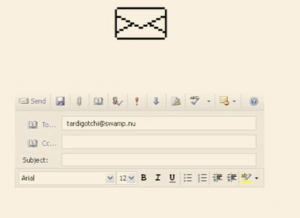
I felt that the use of having the 3D object being displayed was effective as I could associate to the topic that the artist wanted to convey. Other ways that the artist could have chosen to display were the design sketches of the Tardigotchi, or simply put the video up, but I felt that having the object there made it feel real.
Secondary Read
After reading the text, it was then I realized that I was only right about the work being about pets. Firstly, I had not even noticed the other side of the sphere until I read about it, in which I immediately bent down to look at the work from the side.
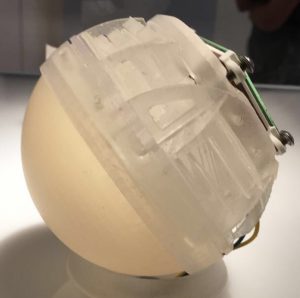
I was also not aware of the fact that the artwork featured two pets, one live and the other artificial. I did not know that the Tardi in Tardigotchi was the Tardigrade that was living on the other side of the sphere, and I even had to google what it was because I was so ignorant (LOL)
It also changed my initial interpretation of the replacement of real life pets with digital ones, as the text help to communicate that there is a living creature and artificial life avatar being taken care of, simultaneously. From this, I felt that the work was able to communicate the topic of humans and technology coexisting, and that neither is less deserving than the other.
The questions posed also had me thinking; does simple interaction cause emotional attachment? As someone who has failed to keep pets, real and digital, over the years, I felt that I could not relate to the theme of pets because both answers would be no. If I were to tackle this issue, I feel that I could relate to this more through daily human to human interaction.
As the idea of using pets is to show that simple interaction of just feeding, bathing and playing, can cause emotional attachment, I felt like this could also be relevant when using babies as subject matter. In my opinion, this would be effective in another perspective. As babies also require very basic physiological needs, a comparison between an android baby and real-life baby could also portray this. This could also pose another question of whether you would put in the same amount of effort into caring for something that does not grow, and something that does.
THAT WAS THEN…THIS IS NOW
THE CENTER OF POSTNATURAL HISTORY, 2015
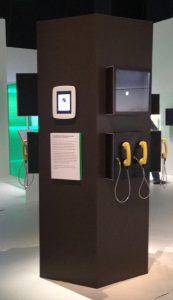
This art work stood out like a sore thumb in the middle of the gallery. It is a work that you can view from all angles, and has artefacts of animals on display. It is interactive as you can pick up the telephone and listen to the audio, giving context to the artefact. Created by the Center for PostNatural Histroy, this work is entitled “That was then…this is now”
From what I could see, the design of it being able to walk around and seen from different angles was an interesting concept because when I first walked up to it, there was no text to accompany the specimens as it was at the opposite side of the structure. Because of this, I was not given any clues at all about what this work could be, and had to make my own interpretations. As for materials wise, I do not think that the material this structure was made out was of importance as it was just a place to hold the specimens.
However, having the specimens there, being enclosed in a case, was better than having them be presented in pictures or video formats as it became more realistic for me. The yellow telephones also stood out and contrasted from the brown background, encouraging people to pick it up and listen into it.
Preliminary Read
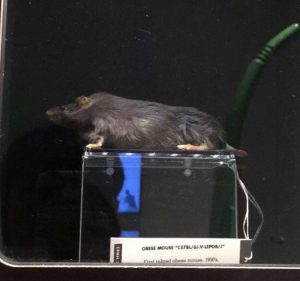
To me, Art and History come hand in hand. I was attracted to this work because I saw a taxidermy rat put on display. Next to it was a fish in a jar, which was also being preserved. At first, these two animals had nothing in common, but as they are being preserved, I was intrigued about what about their history do they have in common.
What I could gather from looking at these two specimens were the that the artist was trying to convey the message of using animals to test human products. I came to this conclusion because I immediately thought of “lab rat”, and the fish being suspended looked like it was in a sort of test tube. To me, I felt that this idea was still within the theme of the exhibition as testing on animals for human products is related to science and technology.
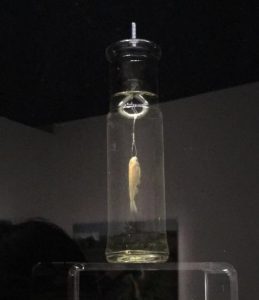
I thought that the artist wanted to address this issue because of the carelessness or inhumane tendencies of people when testing on animals. This is an issue which is still very prevalent till today, as many companies still test their products on animals. I felt that this was also an interesting way to show how technology has advanced, but the methods of people still have not, as the method of testing on animals were definitely different form the past, but the act of testing on them stays the same. A question that popped in my head was “which is the cruel one; technology or humanity?”
When I picked up the yellow telephones, this brought me back to the previous tutorial where there was discussion of sound art. I wondered if this could be considered sound art, because the digital dictation was not the main part of attraction of the work, but it did help to give context. Why did the artist decide to use digital dictation instead of plastering text onto the wall? These were some of the things I wondered too.
Secondary Read
I considered picking up the telephone to be also part of me reading the text of the work as the digital dictation gave me context into what the work was about. From listening to the audio about the rat, it gave me context of the rat being genetically modified. From here, I knew that my interpretation was not too far from what the artist wanted to convey, as I could interpret that these animals were being tampered with technology one way or the other.
After listening to the audio about the fish, it was then I came to the conclusion that the animals that were being put on display were all genetically modified for the benefit of humans. After which, I finally walked to the wall that had the text explaining what the artwork was. The artist, The Center for Postnatural History, finally made sense to me because the text gave context to the fact that these animals had been deliberately altered, making them not natural or authentic anymore. After reading the text, it made me more curious about what other animals had been tampered with, as now I knew that this was what the specimens had in common.
To me, I felt that the presentation of the work was effective in its way of communicating what the artist wanted to show. As the specimens were put on display, it immediately showed that the animals were subjects of technology. The digital dictation was also a good inclusion into the work, as I feel that I would have just walked past something if I had to read a huge text, or watch something that could not be heard properly.
Some Takeaways:
- I felt that this exhibition really showed me that art is prevalent in almost any field, and now it is starting to become more science-y, which i love
- With contemporary art, there is no need for work to be beautiful or require crazy amount of craftsmanship, like of those in the past. As art becomes more abstract, it is more important to represent abstract ideas as the way we live and perceive things are becoming more in depth and advanced.
- This is the age of self actualisation.
All in all, it was an eye opening trip!

